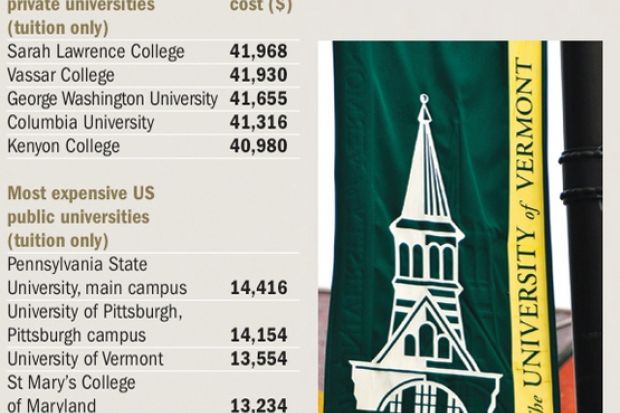There is not much that the US government can do, by law, to force universities to hold down their costs to students. But the government does have one weapon: shame.
Last week, despite objections by universities, the US Department of Education began to reveal which institutions had the highest prices and whose tuition costs were rising at the fastest rates. Those universities will have to explain why costs have gone up and what they have done to tackle the inflation.
"It's a public shaming," said Mark Kantrowitz, publisher of FinAid, an online student guide to financial aid and university costs.
"I have no doubt that the colleges at the top of these lists, their presidents and chancellors are discussing it. Reputation does matter to these institutions."
Price also matters increasingly to students and their families. Observers say that student demand has slowly shifted away from the more expensive universities, and also from four-year degrees to even cheaper two-year degrees at community colleges. Enrolment at the latter group of institutions has shot up per cent since 2007.
"Having a (university) degree has never been more important, but it's also never been more expensive," said Justin Hamilton, a Department of Education spokesman.
"We've got a number of different efforts under way geared towards better arming students with the information they need as consumers to make better education choices."
The result is a new government website, www.collegecost.ed.gov, which includes institution-by-institution figures for the median loan debt incurred by students, the on-time graduation rate, the typical costs for books and supplies, and the job-placement rate.
But there are a few glitches. The institutions listed as the most expensive include several that package their room-and-board costs in with their tuition. They therefore compare unfavourably with competitors that report only the tuition price.
"It's apples and oranges," said Roland Adams, spokesman for Bates College in Maine, which appears to be the most expensive institution in the country. "It is a gigantic difference, and if you take that into account you get a (very) different list."
In fact, ranked by average net price - the amount the average student pays after receiving discounts, scholarships and grants based on need or merit - Bates drops to 462nd out of 1,267 institutions. And its annual tuition increase is only the 831st highest.
"The intent is laudable - to inform the public," Mr Adams said, but he explained that footnotes to the tables make it obvious that the figures are not always directly comparable between institutions.
Universities also could be "gaming" the system, Mr Kantrowitz suggested.
Some subtract student loans from their tuition when they calculate their net prices, for instance - even though those loans ultimately have to be repaid by the students.
Others dangle extra financial assistance in front of arriving students, but withdraw it in later years. All these things can affect an institution's rating relative to that of others.
"A university that gives out more money but to fewer students is going to look better than one that spreads the money around," Mr Kantrowitz said.
The government tables are not the same as the rankings published each year by media organisations. The tables compare only quantifiable measures, mostly related to price, and are not intended to suggest which universities are best.
In fact, the most highly regarded universities are not the most expensive. This is because the US elite have large endowments, allowing them to lavish more financial aid on students.
Some observers suggested that high-priced universities may actually benefit from the attention, attracting the same cachet as luxury cars and high-end designer labels.
In the end, said Mr Kantrowitz, such issues rested on "not just the cost of the college, but also the return on investment. So if the student thinks the net price of the college is high but it's a good return on investment, they're still going to go."
Register to continue
Why register?
- Registration is free and only takes a moment
- Once registered, you can read 3 articles a month
- Sign up for our newsletter
Subscribe
Or subscribe for unlimited access to:
- Unlimited access to news, views, insights & reviews
- Digital editions
- Digital access to THE’s university and college rankings analysis
Already registered or a current subscriber? Login
